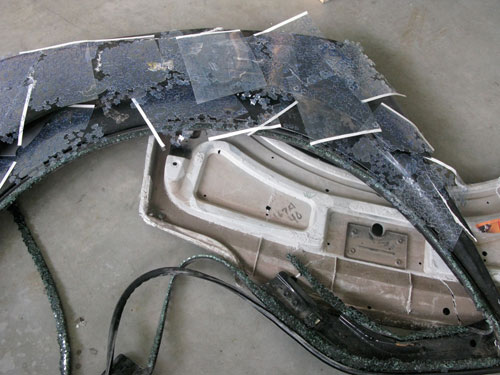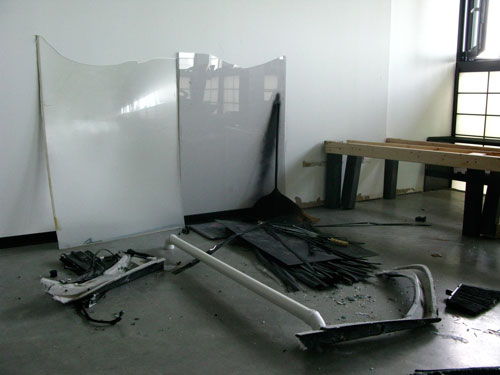-
Blood Drive at Zach Feuer
by Lauren DiGiulio September 16, 2009

Kate Levant splitbroke sheet curve, 2009 Plastics, rubber, fiberglass, broken glass and marker 6 x 52 x 68 inches, via zachfeuer.com
Blood Drive, composed by Kate Levant and presented at the Zach Feuer Gallery, explores the layers of cultural symbolism behind the simple act of giving blood. Effective, if under-realized, the show celebrates the body as a primary active agent in producing useable biological material while gently investigating the limits of socialized connection within an individual-centered culture.
The exhibition is staged in two parts. First, participants engage in the physical act of giving blood through the New York Blood Center, which set up a drive within the gallery space. For us donors, slight physical pain is endured and emotional response evoked as we witness our blood — that encoded material that both defines us as individual and binds us together as a species — flowing out into small plastic bags. Here, the involuntary production of organic matter is consciously introduced as currency into the physical economy of biological exchange , transitioning the role of the body from passive manufacturer to active merchant. By choosing to donate, we perform within the carefully staged medical ritual that facilitates the most direct and democratic contribution an individual can make towards sustaining other human lives. In this intimate physical state, we each become vulnerable and honest.

Kate Levant, highsweep , 2009 Plastics, wood, rubber, fiberglass, broken glass, aluminum and aerosol enamel
The second part of the exhibition is textually based. After donating, participants are given a packet of small booklets to peruse while sipping sugared juice and resting under the vigilant gaze of the medical staff. The booklets are composed of textual material interlaced with graphics by Maude Standish, Kate Levant, Michael E. Smith, and Jacques Vidal, with a photographic essay appendix by Elaine Stocki. An introduction lyrically details the central themes of the work. One leaflet explores the role of the individual in relation to a larger social framework through a narrative account of the role of blood transfusion as ideological vehicle during the formative years of the October revolution. Another focuses on the primary drive of the individual through the connection between the fluidity of performative artistic personality and Freud’s theories of ultimate masochism. A conversation between Jacques Vidal and Noel Anderson reads as a poetic yet focused brainstorm on the appropriation of individual personality within racial identity.
Taken together, these texts read as dramaturgical material that serve to explain and supplement the work from the outside, rather than taking coherent place within the work itself, leaving little room for playful interpretation. A more permeating visual integration of the ideas outlined in these texts would perhaps speak more eloquently to Levant’s message. Why not integrate these richly layered ideas as performance or visual-based interactions instead of including them as a didactic afterthought?
The disjuncture here between these performative and textual elements illustrates a recurrent problem. By compartmentalizing these dual artistic genres, we deny ourselves the opportunity for substantive connection between these forms and ultimately limit both the sensual and the intellectual impact upon the spectator/participant/observer. Kate Levant’s ideas are superb, yet her execution doesn’t quite do justice to their potential.
Blood Drive, comprised by Kate Levant, opened on July 16th and ran through September 4th at the Zach Feuer Gallery.

